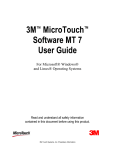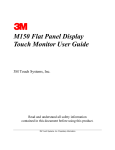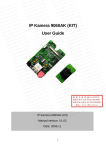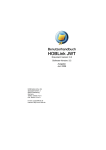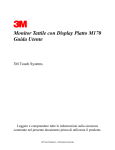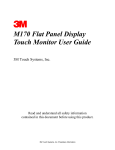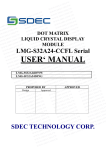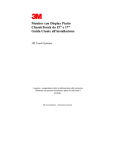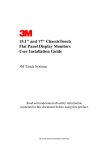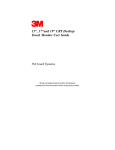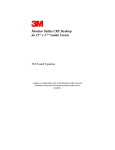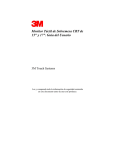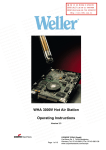Download MT 7.12 Software User Guide
Transcript
MT 7.12 Software User Guide For Microsoft® Windows Vista™ Microsoft® Windows® 2000 Microsoft® Windows® XP Microsoft® Windows® CE Microsoft® Windows® XP Embedded Microsoft® Windows Server™ 2003 3M Touch Systems, Inc. Read and understand all safety information contained in this document before using this product. 3M Touch Systems Proprietary Information 2 MT 7.12 Software User's Guide The information in this document is subject to change without notice. No part of this document may be reproduced or transmitted in any form or by any means, electronic or mechanical, for any purpose, without the express written permission of 3M Touch Systems, Inc.. 3M may have patents or pending patent applications, trademarks, copyrights, or other intellectual property rights covering subject matter in this document. The furnishing of this document does not give you license to these patents, trademarks, copyrights, or other intellectual property except as expressly provided in any written license agreement from 3M Touch Systems, Inc.. The information provided in this document is intended as a guide only. For the latest detailed engineering specifications, please contact your 3M Touch Systems, Inc. Application Engineer. 3M Touch Systems, Inc., Inc is committed to continually improving product designs, as a result, product specifications may be subject to change without notification. In accordance with European Directive 2002/95/EC, "RoHS Directive compliant" means that the product or part does not contain any of the following substances in excess of the following maximum concentration values in any homogeneous material, unless the substance is in an application that is exempt under RoHS: (a) 0.1% (by weight) for lead, mercury, hexavalent chromium, polybrominated biphenyls or polybrominated diphenyl ethers; or (b) 0.01% (by weight) for cadmium. Unless otherwise stated by 3M in writing, this information represents 3M’s knowledge and belief based on information provided by third party suppliers to 3M." NOTICE: Given the variety of factors that can affect the use and performance of a 3M Touch Systems, Inc. Product (the “Product”), including that solid state equipment has operation characteristics different from electromechanical equipment, some of which factors are uniquely within User’s knowledge and control, it is essential that User evaluate the 3M Touch Systems, Inc. Product and software to determine whether it is suitable for User’s particular purpose and suitable for User’s method of application. 3M Touch Systems, Inc. statements, engineering/technical information, and recommendations are provided for User’s convenience, but their accuracy or completeness is not warranted. 3M Touch Systems, Inc. products and software are not specifically designed for use in medical devices as defined by United States federal law. 3M Touch Systems, Inc. products and software should not be used in such applications without 3M Touch Systems, Inc. express written consent. User should contact its sales representative if User’s opportunity involves a medical device application. IMPORTANT NOTICE TO PURCHASER: Specifications are subject to change without notice. These 3M Touch Systems, Inc.’ Products and software are warranted to meet their published specifications from the date of shipment and for the period stated in the specification. 3M Touch Systems, Inc. makes no additional warranties, express or implied, including but not limited to any implied warranties of merchantability or fitness for a particular purpose. User is responsible for determining whether the 3M Touch Systems, Inc. Products and software are fit for User’s particular purpose and suitable for its method of production, including intellectual property liability for User's application. If the Product, software or software media is proven not to have met 3M Touch Systems, Inc. warranty, then 3M Touch Systems, Inc.’ sole obligation and User’s and Purchaser’s exclusive remedy, will be, at 3M Touch Systems, Inc.’ option, to repair or replace that Product quantity or software media or to refund its purchase price. 3M Touch Systems, Inc. has no obligation under 3M Touch Systems, Inc. warranty for any Product, software or software media that has been modified or damaged through misuse, accident, neglect, or subsequent manufacturing operations or assemblies by anyone other than 3M Touch Systems, Inc.. 3M Touch Systems, Inc. shall not be liable in any action against it in any way related to the Products or software for any loss or damages, whether nonspecified direct, indirect, special, incidental or consequential (including downtime, loss of profits or goodwill) regardless of the legal theory asserted. Copyright © 1997-2007 3M. All rights reserved. Printed in the United States of America. Document Title: MT 7.12 Software User’s Guide Document Number: 25695, Version 05 MicroTouch™ Software, Version 7.12 MicroTouch, the MicroTouch logo, and ClearTek are either registered trademarks or trademarks of 3M in the United States and/or other countries. Windows and/or other Microsoft products referenced herein are either registered trademarks or trademarks of Microsoft Corporation in the U.S. and/or other countries. i386 and Intel are trademarks or registered trademarks of Intel Corporation or its subsidiaries in the United States and other countries. All other trademarks are the property of their respective owners. 3M Touch Systems Proprietary Information Contents Introduction About This Manual.....................................................................................................5 Touch Screen Care and Cleaning ...............................................................................5 Contacting Technical Support ....................................................................................6 3M Touch Systems, Inc. Worldwide Offices .............................................................6 Chapter 1 Installing MT 7.12 Software MT 7.12 Software Overview......................................................................................7 Installing MT 7.12 Software ......................................................................................8 Performing a Silent Install........................................................................................11 Completing the Touch Screen Setup ........................................................................11 Uninstalling MT 7.12 Software................................................................................12 Chapter 2 MT 7.12 Software Control Panel Overview ..................................................................................................................13 Opening the MT 7.12 Control Panel ........................................................................13 Main Tab ..................................................................................................................14 Touch Settings Tab...................................................................................................18 Edge Adjustment Tab...............................................................................................20 Edge Adjustment Setting..........................................................................................21 Tools Tab..................................................................................................................23 Controller Tab ..........................................................................................................27 Chapter 3 Windows CE Overview Installation Instructions ............................................................................................33 Instructions For Platform Builder For Microsoft Windows CE 4.0 .........................34 Supporting Multiple Windows CE Versions............................................................34 Supporting Multiple Projects ...................................................................................35 Slow Draw................................................................................................................35 Chapter 4 Windows XP Embedded Overview Installation Instructions ............................................................................................37 Loading MT 7.12 Into The Components Database Manager ...................................37 MT 7.12 Component Selection In Target Designer .................................................37 MT 7.12 Components...............................................................................................38 3M Touch Systems Proprietary Information 4 MT 7.12 Software User's Guide Appendix A Multiple Monitor Setup Overview ..................................................................................................................39 Changing the Controller ID......................................................................................39 Setting Up Multiple Monitors ..................................................................................39 Appendix B Troubleshooting the Touch Screen Overview ..................................................................................................................43 Other Serial Devices do not work ............................................................................43 Multiple Monitor Support ........................................................................................44 Cursor Does Not Reach Edges of Screen .................................................................44 Cursor is Jittery ........................................................................................................44 Cursor Jumps or Bounces Suddenly Across the Screen ...........................................44 Double-Click Doesn't Work .....................................................................................44 Drawing Lines Are Not Straight and Smooth ..........................................................45 Find Touch Screen (for Serial Plug & Play Controllers) .........................................45 Touch Is Not Working..............................................................................................45 Touch Screen Driver Did Not Load .........................................................................46 Right-click tool buttons are swapped .......................................................................46 A Previous Version of TouchWare Software Was Detected....................................47 3M Touch Systems Proprietary Information Introduction About This Manual This manual describes how to: • • • Install MT 7.12 software for your touch screen and specific operating system. Use the MT 7.12 control panel to customize your work environment. Troubleshoot the touch screen. Before installing MT 7.12 software, you must complete the appropriate hardware connections for your controller. For instructions, refer to the your MicroTouch™ Controller Reference Guide. All technical documentation can be found on the 3M Touch Systems, Inc. website at www.3mtouch.com. The drivers included in MT 7.12 will support the following: • • • All current controllers (no legacy controllers) and chipset designs based on EX II or SC series. Capacitive and resistive touch technologies (including Touch Pen). Both USB and RS-232 communication protocols. Touch Screen Care and Cleaning The touch screen requires very little maintenance. 3M Touch Systems, Inc. recommends that you periodically clean the glass touch screen surface. Typically, an isopropyl alcohol and water solution ratio of 50:50 is the best cleaning agent for your touch screen. You can also use straight isopropyl alcohol. In addition, the 3M Keyboard and Screen Cleaning Kit CL680 has been tested and approved for this use. CAUTION To avoid the potentially hazardous situations associated with the use of alcohol or other solvents which may result in minor or moderate injury or property damage: • Follow all instructions and recommendations in the manufacturer's Material Safety Data Sheet and product label. • Be sure to follow solvent manufacturer's precautions and directions for use when using any solvents. • It is important to avoid using any caustic chemicals on the touch screen. Do not use any vinegar-based solutions. 3M Touch Systems Proprietary Information 6 MT 7.12 Software User's Guide Apply the cleaner with a soft, lint-free cloth. Avoid using gritty cloths. Always dampen the cloth and then clean the screen. Be sure to spray the cleaning liquid onto the cloth, not the screen, so that drips do not seep inside the display or stain the bezel. Always handle the touch screen with care. Do not pull or stress cables. Contacting Technical Support 3M Touch Systems, Inc. is committed to helping you get the most out of your touch screen by providing extensive Technical Support. Visit the 3M Touch Systems, Inc. website at http://www.3Mtouch.com/, where you can download touch screen software and drivers, obtain regularly updated technical documentation on 3M Touch Systems, Inc. products, and learn more about our company. Whenever you contact Technical Support, please be prepared to provide the following information: • • • • • Display manufacturer and model number Touch screen part number and serial number Current driver version Operating system used Information on additional peripherals Technical Support is available Monday through Friday 8 a.m. to 8 p.m. US Eastern Standard Time – 9 a.m. to 5 p.m. throughout Europe. You can contact 3M Touch Systems Technical Support (US only—Eastern Standard Time) by calling the hot line, sending email or a fax. • • • • Technical Support Hot Line: 978-659-9200 Technical Support Fax: 978-659-9400 Toll Free: 1-866-407-6666 Email: [email protected] 3M Touch Systems, Inc. Worldwide Offices Contact information for all offices can be accessed through the website: http://www.3Mtouch.com/. 3M Touch Systems Proprietary Information CHAPTER 1 Installing MT 7.12 Software This release of MT 7.12 Software (MT 7.12), the newest member of the MicroTouch™ Software Suite, provides support for MicroTouch™ touch screen operation for all applications running under Microsoft® Windows® 2000, Microsoft® Windows® XP, Microsoft® Windows® CE, Microsoft® Windows® XP Embedded, and Microsoft® Windows® Server™ 2003. MT 7.12 allows users to select, launch, and drag objects using the touch screen. To select, users simply touch the screen. It is that easy and natural -- just touch to select. MT 7.12 Software Overview Your touch product includes several software tools to help you work with and customize the touch screen. Specifically, MT 7.12 software includes the following programs and utilities: • • • • • Touch screen drivers Control panel Online help Software uninstall utility Calibration tool Touch Screen Drivers Touch screen drivers are the software the system uses to communicate with the touch screen controllers. MT 7.12 software includes drivers for applications running in different operating environments. You can run programs and use touch (finger or stylus) input without any program modifications. 3M Touch Systems Proprietary Information 8 MT 7.12 Software User's Guide MT 7.12 Control Panel You can use the MT 7.12 control panel to set your preferences for the touch screen. For example, you can define the following preferences: • • • Whether the touch action occurs when you touch the screen or when you lift your finger (or stylus) off the screen. Whether you hear a sound when you touch the screen. How fast you need to touch to produce a double-click (except WinCE). You can also use the MT 7.12 control panel to calibrate the touch screen and run optional programs. Online Help MT 7.12 software has extensive online help for setting up and using the touch screen. You can launch help from the control panel. MT 7.12 Software Uninstall Utility The Uninstall utility automatically deletes all MT 7.12 software components from your computer and removes most MT 7.12 software entries from the system files. Calibration Tool This tool enables you to calibrate your touch screen without launching the control panel. Microsoft WHQL Certification Note that the MT 7.12 touch screen driver is WHQL certified. WHQL certification is designed to ensure that the new hardware device complies with operating system requirements. Without the WHQL certificate, the user is notified of ‘potential compatibility issues’ when installing the device. Installing MT 7.12 Software Note: For specific installation instructions for Windows CE and Windows XP Embedded, refer to chapters 3 and 4. When you install MT 7.12 software, you have several installation options: • • • • Typical Install (basic features needed to support touch) Full Install (installs all components) Custom Install (select which components you wish to install) Upgrade (if you have MT 7 software already, will update the components you have installed) To install MT 7.12 software: 3M Touch Systems Proprietary Information Installing MT 7.12 Software 9 1. Make sure you have completed the appropriate hardware connections. Serial controllers should be connected before you begin. The controller can then be automatically detected and there will be no need to reboot. 2. Power on your system. Make sure no other applications are open. 3. Download the MT 7.12 Software program (MT_7_Win32.zip) from the www.3Mtouch.com website. Unzip the file into a directory of your choice. Using Windows® Explorer, browse to that MT 7.12 folder and double-click the Setup.exe file. 4. Follow the onscreen instructions to begin the installation. 5. When prompted to choose the installation type, select whether to perform a Typical Install, Full Install, or Custom Install (or, if available, Upgrade). During installation, you may get messages about finding new hardware. This is the MT 7.12 driver searching your serial ports for touch screen controllers. The Typical option automatically installs the minimum required MT 7.12 software files, creates a MT 7 program group and control panel. If you choose Custom or Upgrade, you can select which components to install. The following components are available: Controller Support, User Interface and Utilities and Tools. Controller Support Various controller support is available. By default, all controller support is installed. If you do not want to support a specific controller, deselect that component in either the upgrade or custom setup screens. 3M Touch Systems Proprietary Information 10 MT 7.12 Software User's Guide User Interface The User Interface provides the following components: • The Control Panel is used to configure the touch screen • Online Help files are recommended for user assistance • The Calibration Tool is recommended if you are not loading the Control Panel. • The Multiple Monitor Manager enables you to set up multiple monitors with touch screens. You must load this file in order to configure multiple monitors. Utilities and Tools This option enables you to hide the cursor. 3M Touch Systems Proprietary Information Installing MT 7.12 Software 11 Performing a Silent Install If you have to perform multiple system installations, you may want to take advantage of the MT 7.12 software silent install. To begin, you must create a silent install script that contains the recorded installation instructions. You create this script by running the Setup program in record mode. During a silent install, the Setup program receives input from the recorded install script rather than from a user. Once you record an installation script, you can run it on as many similar systems as you like. The first step in producing a silent installation is to record your standard installation. Open a command line window and set your working directory to the directory containing the MT 7 for Windows setup program. Issue the command "setup -r" and run the installation normally. When the installation finishes, it creates a recording file, setup.iss, in your Windows system directory (such as C:\Windows). Copy this file to the directory containing the MT 7 for Windows setup program. To run the silent installation, simply issue the command "setup -s". This replays the installation you recorded above. Note that the silent installation fails if the installer reacts differently than when it was recorded. For example, if you record an installation using the "Upgrade" option and replay it on a system without MT 7 for Windows, the installation may fail. You should test the silent installation on all expected configurations. Since the recording process creates a file, the MT 7.12 program must be on a hard drive and not on a CD-ROM. Once the file is created, you can make a CD-ROM, or equivalent media, with the distribution files and the setup.iss file. Your use this CD-ROM is subject to the license agreement of this software. This feature does not give you the right to distribute this software if that right is not already granted to you by the license agreement. Completing the Touch Screen Setup Once you have installed MT 7.12 software, you can optimize the performance of the touch screen using the MT 7.12 Control Panel. You can adjust settings for touch sounds, double-click speed, and double-click area (not applicable to WIN CE systems). Note: You can define touch screen settings using the MT 7.12 Control Panel. MT 7.12 stores the touch screen settings in the Windows® system registry. Whenever you save changes to the MT 7.12 Control Panel, MT 7.12 software records the new settings in the system registry. These changes take effect immediately. 3M Touch Systems Proprietary Information 12 MT 7.12 Software User's Guide Uninstalling MT 7.12 Software The Uninstall program removes all MT 7.12 software components from your computer. These components include MT 7.12 software files, directories, folders, and registry key items. The Uninstall program also removes all MT 7.12 software entries from the system registry files. To uninstall MT 7.12 software: 1. Close MT 7.12 software if it is open. 2. Click on Start → Programs → MicroTouch → MT 7 → Uninstall MT 7 Software The path may be different if you performed a custom installation and chose a custom name for the MT 7.12 software program group. 3. Follow the onscreen instructions to remove MT 7.12 software. 3M Touch Systems strongly suggests you reboot your system when complete. 3M Touch Systems Proprietary Information CHAPTER 2 MT 7.12 Software Control Panel Overview The MT 7.12 software control panel consists of tabs that allow you to determine the best settings for your touch screen configuration. • • • • • Use the Main tab to run a 3-point calibration routine for optimum accuracy of your touch screen. Use the Touch Settings tab to define the touch actions that equate to mouse actions and add right-click functionality to the touch screen. Use the Edge Adjustment tab to define a frame around the active touch area in which the cursor moves closer to the edges of the screen. Use the Controller tab to activate linearization, select frequency, set controller ID, and determine pen/finger modes. Note that this tab appears only if you have selected the appropriate options from the Advanced Options from the Tools tab and have the specific type of controller attached to your system. Use the Tools tab to restore hardware or software defaults, reset controller, run Draw Test from the desktop, and to enable Advanced Options for your touch screen. Opening the MT 7.12 Control Panel You can open the MT 7.12 control panel by clicking: Start → Programs → MicroTouch → MT 7 → Control Panel. 3M Touch Systems Proprietary Information 14 MT 7.12 Software User's Guide Main Tab This tab covers touch screen calibration as well as basic support information. Calibration The calibration process aligns the touch screen with the underlying video. Specifically, calibration defines the dimensions of the active area of the touch screen and locates the center of the touch screen. If the screen is not calibrated, the active area of the touch screen may not be aligned properly or may be unnecessarily small. You should calibrate the touch screen in the following cases: • • Any time you change the size and position of the video image by adjusting the horizontal and vertical controls on your monitor. Any time the cursor does not follow the movement of your finger, or does not reach the edges of the touch screen. If you continue to need additional accuracy along the edges, use the Edge Adjustment tab. Calibrating the Touch Screen 1. Select the Main tab. 2. Click the Calibrate button. 3M Touch Systems Proprietary Information MT 7.12 Software Control Panel 15 Note: If you are using a TouchPen and you are in Pen/Finger mode, a dialog will ask whether you wish to calibrate using Pen or Finger. Calibrate using each option separately and when you are done, MT 7.12 will restore your TouchPen mode to Pen/Finger. 3. A calibration target appears in the lower left corner of the touch screen. Note: If you press Escape or do not touch the screen within twenty seconds, the system automatically cancels the calibration process with no change to the current settings. 4. Touch the screen positioning your fingertip to completely cover the green target. This position is calculated upon liftoff and when you remove your finger, the target should turn red. When touching the calibration target, make sure to: • Face the monitor directly. • Perform the calibration in the position (sitting or standing) you expect to normally use the touch screen. • Touch the calibration target firmly and precisely with your fingertip. During Calibration, be careful to keep your fingernails and other fingers away from the touch screen as you touch the target. 5. Repeat these instructions for additional calibration targets. 6. Once you have calibrated the touch screen, a dialog box will appear to ask if you wish to test, accept or cancel this calibration. • If you select Accept, then the new calibration settings are automatically accepted. • If you select Test, then a Draw (refer to the Tools tab for more details) screen appears. When you exit Draw mode, a dialog will prompt, “Are you satisfied with the results?” • • Selecting Yes will keep the new calibration settings. • Selecting No will restore the original (pre-calibration) settings. If you select Cancel, the original settings will be restored without change. Testing the Calibration If you accidentally liftoff from the screen in the wrong place during calibration, you will distort the touch screen calibration. Test by touching several points on the screen to make sure you are satisfied with the calibration results. The cursor should be located underneath your finger or pen when you touch the screen. Repeat the Calibration process until you are satisfied. Recalibrate the touch screen if any of the following tests fail. 3M Touch Systems Proprietary Information 16 MT 7.12 Software User's Guide • • • • • Touch random points on the screen. The cursor should be located underneath your finger or pen when you touch the screen. Drag your finger across the screen and check that the cursor follows your movements. Touch each corner and along the edges of the screen. Verify that the cursor reaches the full image area of the screen. Be sure you can touch and activate all icons and menus across the entire screen. If you are using a TouchPen, repeat the calibration procedure with the pen. If you need to recalibrate the screen, make sure to touch the targets carefully. It is possible that one of your touches did not register properly or you accidentally touched the screen in the wrong place during calibration. For example, if you touch beyond the targets or into the non-image area, you will distort the touch screen calibration. Controller Information This information helps identify your system setup for troubleshooting purposes. If for any reason you need to call Technical Support, this information will be useful. Controller ID On the Main tab, this is an information-only field in a single controller situation – if you have more than one controller you can select the specific controller you want to adjust. This field identifies the controller(s) attached to your system. It will display unique identifiers for each controller attached to your system in a drop box. When you select a controller from this list, the Controller tab will reflect only this controller – any changes will be made only to this controller. • For EX II controllers, serial controller values include PORTCOM1, PORTCOM2, PORTCOM3, etc. • For other serial controllers values include SER00000001, SER00000002, etc. • USB controller values include USB00000001, USB00000002, or USB00000003. Controller Type This field displays the type of controller currently attached to your system. This data may be useful for Technical Support issues. The only controllers supported with this release are as follows: • • EX II-based serial and USB capacitive and resistive controllers (including TouchPen) SC 400, 500 and 800-based resistive serial and USB controllers Firmware Version These digits represent the version number and revision level of the touch screen controller firmware. 3M Touch Systems Proprietary Information MT 7.12 Software Control Panel 17 Touch Screen Status Touch Screen Status refers to whether or not the touch screen has been found and is operational. Possible messages include: • • • • • • • • • OK – Touch screen found and operational. BLK Error – Touch screen hardware error such as a checksum error in controller EEPROM. CBL Error – Cable NOVRAM missing – this is only an error in systems requiring cable NOVRAM. HDW Error – Touch screen hardware error. LIN Error – Block 2 error. NOV Error – Checksum error in NOVRAM, using defaults. PWM Error – Touch screen hardware error. ROM Error – Checksum error in ROM. SET Error – Unable to establish operating range at power-up. Any other condition indicates a hardware failure. Contact Technical Support for more information. 3M Touch Systems Proprietary Information 18 MT 7.12 Software User's Guide Touch Settings Tab The Touch Settings tab enables you to customize the response of your touch screen. You can change the way the system responds to your touch, add a right-click tool to your desktop, tell your system to beep on touch, and define the double-click speed and area of your touch. Touch Mode The available Touch Mode options are Drawing, Touchdown, and Liftoff. Drawing Mode (Default Value) Drawing Mode is most useful for draw, paint, illustration, and graphics applications. In Drawing Mode, a touch is equivalent to pressing and holding down the mouse button. This is considered the easiest mode to use with an immediate reaction to touch. Lifting off is equivalent to releasing the mouse button. • To click, touch the object. Lift off the screen. • To double-click; touch the object twice quickly at the same location. • To drag, touch the object. Slide your finger to the new location. Lift off the screen. 3M Touch Systems Proprietary Information MT 7.12 Software Control Panel 19 Touchdown Mode Touchdown Mode enables you to create an immediate button action as soon as you touch the screen. In Touchdown Mode, you cause a button down at the cursor location, with a short pause and then a button up. You can leave your finger on the screen but only a single touch is registered until you lift your finger off the screen and touch down again. Touching the screen is equivalent to pressing and releasing the mouse button. The action occurs as soon as you touch the screen. This mode is best for button-based applications (like a calculator). Drawing or dragging is not supported in this mode. Liftoff Mode Liftoff Mode enables you to position the cursor where you want before creating a button action. In Liftoff Mode, the cursor will follow your finger for a more accurate touch. When you want to select an item, lifting your finger off the screen will cause a button down, short pause, and then a button up to occur. Touching the screen is equivalent to moving the mouse position. The button down/button up action occurs when you remove your finger from the screen. This mode is useful for applications requiring greater accuracy because it lets you carefully position the cursor before acting on it. Drawing or dragging is not supported in this mode. Right-Click Tool This option places an icon on the desktop (always on top of your application) that allows you to select which mouse button to activate on touch. Note that this works for the next click action only. Control returns to the left mouse button as soon as you are done. You can position this icon anywhere on your desktop by selecting it, pausing until the four-pointed arrow appears, and dragging it wherever you want. Left button is typically used for normal select and normal drag. Right button is typically used for applet properties such as context menu and special drag. Touch Sound Select audible beep on touchdown, liftoff, or no beep at all. Click on the Beep button to select the appropriate option for your application. The default setting is no beep on touch (Beep off). Double-Click Speed (not available on Windows® CE) Double-click speed defines how quickly you must touch the screen for the system to interpret your actions as a double-click. Set the double-click speed in the slow to medium range for optimum performance with a touch screen. Touch the globe twice to test the double-click speed and area settings. If the globe begins to spin, the touch screen recognized your touch as a double-click. 3M Touch Systems Proprietary Information 20 MT 7.12 Software User's Guide Note: Changing this setting will affect the double-click setting of the mouse. Double-Click Area (not available on Windows® CE) Double-click area defines the space in which you must touch the screen for the system to interpret your actions as a double-click. Set the double-click area in the medium to high range for optimum performance with a touch screen. Touch the globe twice to test the double-click speed and area settings. If the globe begins to spin, the touch screen recognized your touch as a double-click. Note: Changing this setting will affect the double-click setting of the mouse. Edge Adjustment Tab Once you calibrate the touch screen, the cursor should be located directly beneath your finger when you touch the screen. However, this may make it difficult to touch items at the very edges of the screen. The Edge Adjustment tab enables you to define an offset area in which the cursor moves closer to the edges of the screen so you can easily and more precisely select small items, such as single words, the Windows Start button, check boxes, or radio buttons. For example, if you have a row of buttons along the left edge of your touch screen, you may want to set an edge adjustment to enable users to easily activate these buttons. Because each edge is independent of the other, you only need to adjust the left margin to accommodate this row of buttons. 3M Touch Systems Proprietary Information MT 7.12 Software Control Panel 21 Edge Adjustment Setting To set the Edge Adjustment, move the sliders inward to define the offset area. These changes take effect immediately. Click Test to preview your choices. The area you have defined appears as a colored area as shown below. Within this colored area, the cursor will automatically move ahead of your finger so you can more easily touch items closer to the edge. 3M Touch Systems Proprietary Information 22 MT 7.12 Software User's Guide Determine if the area you have defined is sufficient for your needs. Can you touch into the corners and along the edges of the screen? Click Escape, End Test, or Return to go back to the Edge Adjustment tab. If you are satisfied with the selections you have made – you are done. If not, adjust the sliders to better accommodate your needs. 3M Touch Systems Proprietary Information MT 7.12 Software Control Panel 23 Tools Tab The Tools tab enables you to perform a variety of diagnostics to optimize the performance of your touch screen. This tab is also the gateway to advanced touch screen options. Component Versions This is an informational screen for diagnostic purposes that details the building blocks of MT 7.12 and its version numbers. 3M Touch Systems Proprietary Information 24 MT 7.12 Software User's Guide Draw Test Note: You must be in Draw mode for this to work properly. The Draw program lets you test the operation of the touch screen and pen by checking the accuracy and speed with which the system responds to your touch. To draw, simply touch the screen and drag your finger or pen. The following options will help you use the draw program more effectively: • • • • • Press B (blank) to clear the screen and display a blank drawing canvas. Press G (grid) to clear the screen and display a grid that you can use as a drawing guide (default setting). Press L (line) to draw solid lines on the screen (default setting). Press D (dots) to draw dotted lines on the screen, where each dot represents a point reported by the touch screen. Press the Space Bar to clear the screen. 3M Touch Systems Proprietary Information MT 7.12 Software Control Panel 25 Restore Factory Settings Software The Reset Software option is useful if you have reconfigured the MT 7.12 software and need to get back to a working state. This option will restore supplier factory configuration settings. If none exist, it will reset to 3M Touch System defaults. Controller The Restore Controller option is useful if you have reconfigured the controller and need to get back to a working state. Pressing this button restores 3M Touch System factory-set system defaults. If after restoring controller factory defaults, you lose touch, you will need to reboot in order to restore touch. Note: You must perform a calibration after restoring controller defaults. Reset Controller Use this only at the direction of Technical Support. This command initializes the hardware and the firmware, causes the controller to stop sending data, and recalculates the environmental conditions (for example, stray and offset values). The Reset command also cancels existing commands and returns the controller to normal operation. 3M Touch Systems Proprietary Information 26 MT 7.12 Software User's Guide Advanced Touch Screen Options Important Note: Executing the Advanced Options may alter the performance of your touch screen or render it inoperable. You should be aware of expected results before executing any option. If you are not familiar with the outcome of these settings, you should not be using these options. This option controls certain advanced functions for your controller. Depending on the options you have selected and the availability of that function for your given controller, you can choose certain Advanced Options from this screen. • • • • Enable manual linearization (only for EX II and some SC series controllers) Enable pen/finger selection (only for Touch Pen controllers) Enable frequency selection (only for EX II capacitive controllers) Enable controller identifier editing (helpful in multiple monitor setups) Refer to the Controller Tab for a discussion of the various options associated with these Advanced Options settings. 3M Touch Systems Proprietary Information MT 7.12 Software Control Panel 27 Controller Tab The Controller tab contains different choices depending on the type of touch screen controller(s) you have attached to your system and which options you selected from the Advanced Options from the Tools tab. Controller Type If you have more than one controller attached to your system, this field displays the controller currently selected on the Main tab. This data may be useful for Technical Support issues. The controllers supported with this release are as follows: • • EX II-based serial and USB capacitive and resistive controllers (including TouchPen) SC 400, 500 and 800-based resistive serial and USB controllers Depending on the options you have selected and the availability of that function for your given controller, the following items may appear: • Linearization • Touch Screen Frequency • Pen/Finger Selection • Controller ID 3M Touch Systems Proprietary Information 28 MT 7.12 Software User's Guide Linearization With certain controllers, you can perform a linearization to fine-tune your touch screen. It should be performed only at the direction of 3M Touch Systems, Inc. Technical Support. Linearization consists of touching 25 targets on the screen followed by 16 additional points to determine specific point accuracy over the face of the display. The following controllers support Linearization: • • • EX II based Touch Pen SC 500 series Linearization Process To perform a 25-point linearization of the touch screen: 1. Make sure the video image is centered in the screen area using the horizontal and vertical controls. 2. Open the touch screen control panel and select the Controller tab. 3. Click Linearize. This will bring up, one at a time, 25 linearization targets on the screen. Note: If you press Escape or do not touch the touch screen within 20 seconds, the system automatically cancels the linearization process with no change to the current settings. 4. Touch the touch screen and position your fingertip to completely cover the green target. When touching the target, make sure you: a. Face the monitor directly. b. Perform the linearization in the position (sitting or standing) you expect to use the touch screen. c. Touch the target firmly and precisely with your fingertip. Be careful to keep your other fingers away from the touch screen as you touch the target. Hold a steady touch over the target until you hear a beep or until the target turns red. 5. Repeat these instructions until all 25 targets have been touched. A dialog will appear asking if you wish to continue. If so, the 25 targets will now be replaced with a set of 16 targets used to verify the linearization performed in steps 1 through 5. These targets are yellow to begin with. If you successfully touch the target, it turns green. If you are off, it turns red and returns a percentage error number. If the linearization is not within acceptable tolerances, you should perform the linearization process again. Repeat the previous process for each of these targets. This process automatically returns to the control panel once complete. If you are using a Touch Pen, repeat the linearization procedure with the pen. 3M Touch Systems Proprietary Information MT 7.12 Software Control Panel 29 To test the accuracy of the linearization process, use the Draw Test program (found on the Tools Tab) to draw some lines on the screen. Check that they are smooth, straight, and thin. You do not want lines to look keystoned or curved. To exit this program at any time during the process, press Escape. Pen Overview (Touch Pen Controller Only) From the Tools tab, click on Advanced Options and select Enable Pen/Finger Selection. These options are available only if your system has a Touch Pen controller. Touch Pen Mode defines whether the touch screen recognizes input from both a pen and a finger, from a pen only, or from a finger only. The default mode is Pen/Finger, which means that you can use either your finger or your pen to select options. Certain pens come with a button that can be used for right-clicks. To right-click, press and hold the button while you touch the screen. After touching the screen, quickly lift the pen and release the button. Note the touch pen mode is immediately active. For example, if you select Pen Only, the system recognizes only the pen as a touch device. You cannot use your finger to make a selection. You can still use the mouse to select an option. The system saves the touch pen mode so that the next time you power up the system, the selected pen mode is active. Pen and Finger Calibration On a Touch Pen system, you must calibrate the touch screen twice, (once with your finger and once with the pen) if you are using Pen/Finger mode. Touch Pen Modes Note: Changing the Touch Pen mode setting can optimize the performance of the touch screen. In Pen/Finger mode, the Touch Pen controller checks for input from either a pen or a finger. The Touch Pen controller always gives priority to the pen. If you are not currently using the pen for your touch application, use Finger Only mode for optimum system performance. If you are not currently using your finger for your touch application, use Pen Only mode for optimum system performance. Pen only mode—The system recognizes only pen touches on the screen. The system ignores finger touches on the screen. Finger only mode—The system recognizes only finger touches on the screen. The system ignores pen touches on the screen. 3M Touch Systems Proprietary Information 30 MT 7.12 Software User's Guide Pen and finger mode—The system recognizes both pen and finger touches on the screen. This mode is the default mode for Touch Pen controllers. If the system detects both pen and finger touches at the same time, it gives the pen higher priority and acknowledges only the pen touches. This priority prevents accidental touches from your finger or hand being interpreted as input. If you are using the pen and you lift the pen from the screen, the system does not recognize finger touches until after a system-defined time delay. If your finger is on the screen when the pen lifts off, the system ignores the finger until you lift off and touch the screen again. For example, if you rest your hand on the screen while you write with the pen, you can lift the pen and put it back again without your hand touch being acknowledged. Touch Screen Frequency Note: This option only applies to capacitive EX II-based controllers. From the Tools tab, you can choose the Advanced Options button. From the Advanced Options dialog, select Enable Frequency Selection to activate this option on the Controller tab if you are using a capacitive EX II-based controller. This option adjusts the operating frequency of the touch screen controller. In general, you will not need to adjust the touch screen frequency. However, if you are experiencing problems with a jittery cursor, ragged lines, or random touch points, you may want to run the Enable Frequency Selection option. Use the Enable Frequency Selection option to test the available frequency settings and determine the best frequency. The range of frequency settings and the default setting depends on your touch screen controller. You can set a new operating frequency, and then check the performance of the touch screen at that frequency setting. Be aware that if you choose Restore Factory Settings → Controller from the Tools tab, you will change the touch screen frequency to the factory default setting. You may need to redo the Touch Screen Frequency at this time. Touch Screen Frequency Procedure From the Tools tab, you can choose the Advanced Options button. From the Advanced Options dialog, select Enable Frequency Selection to activate this option on the controller tab if you are using a capacitive EX II based controller. In the Touch Screen Frequency box, you will see a pull down list of several frequency options. In general, the highest possible frequency will provide the best results. Once you change the frequency, do not touch the screen for approximately 30 seconds. Touch will return when the frequency has been changed. Test to see if you are satisfied. On a Touch Pen controller system, you have the option to change the frequency for both your finger and the pen if you are using Pen/Finger mode. 3M Touch Systems Proprietary Information MT 7.12 Software Control Panel 31 Testing the Newly Selected Frequency Any time you adjust the Touch Screen Frequency you should test how the touch screen is working and verify you are satisfied with the operation of the touch screen. Test the touch screen by touching the screen in several places and sliding your finger around the screen. The cursor should hold steady and smooth. If you see erratic or jittery cursor movement, readjust the touch screen frequency. Adjust the frequency until your touch test produces acceptable results. A good test is to go to the Draw program and hold your finger steady on the screen. If the resulting pattern is a crisp and clear single dot, you should have a good frequency. It is recommended that you recalibrate the touch screen after you run the Touch Screen Frequency option. Controller ID Note: Changing this field will affect your multiple monitor setup. From the Tools tab, you can choose the Advanced Options button. From the Advanced Options dialog, select Enable Controller Identifier Selection to activate this option on the controller tab. If you do not have a multiple monitor setup, you do not need to use this field. Please refer to the Multiple Monitor section for more information. 3M Touch Systems Proprietary Information CHAPTER 3 Windows CE Overview MT 7.12 Software, a member of the MicroTouch™ Software Suite, provides unified driver support for MicroTouch touch technologies over a wide range of operating systems. This version, 7.12, supports Microsoft® Windows® CE operating systems, versions 4.0, 4.1, 4.2, 5.0, and 6.0. Intended for touch system integrators, MT 7.12 provides flexibility in defining how the touch screen affects the system. This product includes a Touch Screen Driver, a Control Panel, a Calibration Tool, and a Multiple Monitor Tool. Installation Instructions Using Windows Explorer, browse to the software distribution and double-click on the Setup program to start the installation. If you downloaded the distribution, unzip the file into another directory. The Installer requires that Platform Builder be installed in your Windows 2000 or XP machine. The Installer puts the driver and any tools selected by user into the proper Platform Builder directories. Follow the instructions given by the Setup program. First, you will be asked to browse to a directory in your Platform Builder installation. Normally a platform directory will look like this: C:\WINCE###\PLATFORM\CEPC\FILES Or a specific project directory, such as this: C:\WINCE###\PUBLIC\MyProject\WINCE###\CEPC\OAKS\FILES The Installer places most its files in a central directory called "C:\MT7_CE\x86.” This allows multiple Platform Builder platforms and projects to access the same files. The Installer attempts to change the Platform.bib and Platform.reg, or Project.bib and Project.reg, files in a Platform Builder system. 3M Touch Systems Proprietary Information 34 MT 7.12 Software User's Guide The changes are "#include" directives that add MT 7.12 components to your target system. With the Installer, you may choose to customize your installation. This allows you to select which components to install. The following components are selectable. • • • The Touch Screen Driver is mandatory to operate the touch screen. The Calibration Tool is recommended. The Control Panel includes calibration support and is recommended if additional settings are needed. The Installer produces a file, TwTouch.bib that reflects the components you selected. For the touch screen driver to work, you must include USB support in your Windows CE image, regardless of the type of touch screen you use. Instructions For Platform Builder For Microsoft Windows CE 4.0 As installed, MT 7.12 should operate under the Platform Builder for Windows CE 4.1 and above without any user changes. The MT 7.12 Installer places an "#include" directive in Platform.reg and Platform.bib to include the files TwTouch.reg and TwTouch.bib. In Platform Builder 4.0 this directive does not work. Therefore you need to replace this "#include" directive with the contents of the MT 7.12 files. Edit Platform.bib and locate the include directive for TwTouch.bib. Open TwTouch.bib in another editor, copy its contents to the clipboard and paste the clipboard into Platform.bib, replacing the include directive. Save Platform.bib. Repeat the editing with Platform.reg, replacing the include directive with the contents of TwTouch.reg. If you installed MT 7.12 into a project instead of a platform, the files you need to edit are Project.bib and Project.reg. Supporting Multiple Windows CE Versions The MT 7.12 Installer provides a different version of the driver for each version of CE starting with 4.0 and later. Even though version 4.0 of the driver appears to work on later versions of CE, you may want to replace the default 4.0 selection with the matching version of CE. Inside TwTouch.bib, locate the line that includes TwTouch.dll and replace the "\400" in the path with "\410,” "\420" or "\500,” depending on the Platform Builder you are using (4.1, 4.2 or 5.0). Save TwTouch.bib and exit the editor. 3M Touch Systems Proprietary Information Windows CE Overview 35 Supporting Multiple Projects By default, the Installer places MT 7.12 in a central directory where it can be referenced by multiple projects. It also installs the TwTouch.reg and TwTouch.bib files in a single platform or project directory. Finally it adds include statements to the Platform.bib and Platfom.reg or Project.bib and Project.reg referencing the TwTouch.* files. To include MT 7.12 in additional platforms or projects, follow these steps. Re-run the installer and browse to a new platform or project directory, which contain either Platform.bib and .reg or Project.bib and .reg files. If using Windows CE 4.0, then see the section "Instructions for Platform Builder Version 4.0" above for details. If all your projects use the same MT 7.12 configuration, then there is nothing more to do. You should be able to build your projects. In the TwTouch.reg file of each project, an "#include" directive points to C:\MT7_CE\X86\TwParam.reg. Change this directive to point to the project-specific copy of this configuration file. If you installed MT 7.12 into a project instead of a platform, the file you need to edit is Project.bib. Be aware that if you install multiple copies of MT 7.12 in different projects the uninstall will remove the central copy of MT 7.12 causing all other projects to lose the MT 7.12 references. Therefore, instead of using uninstall, simply delete the include statements from the particular project files. Slow Draw Using Draw mode can be slow on certain Windows CE machines. For example, drawing a curve inside a draw application may produce ragged lines and the cursor may lag behind. The "IOPollDelay" parameter adjusts the behavior of draw mode. Adjusting the default value of this parameter may improve the behavior and appearance of the curve without affecting overall performance of the Windows CE system. You can add this parameter to the system by editing the text file TwParams.reg found in C:\MT7_CE\x86. To add this parameter with a new default value insert the IOPollDelay line after the line below: [HKEY_LOCAL_MACHINE\Drivers\BuiltIn\TwTouch\Parameters] "IOPollDelay"=dword:1(value) A value between 1 and 20, such as 10 may work best for your particular application. After adding or modifying the value of this parameter, you need to rebuild the Windows CE image and test the draw behavior. 3M Touch Systems Proprietary Information CHAPTER 4 Windows XP Embedded Overview MT 7.12 Software, a member of the MicroTouch™ Software Suite, provides unified driver support for MicroTouch touch technologies over a wide range of operating systems. This 7.12 version supports Microsoft Windows® XP Embedded (XPe) operating system. This product includes a Touch Screen Driver, Control Panel, Calibration Tool, and Multiple Monitor Tool that provide enhanced touch features on your system. Installation Instructions Using Windows Explorer, browse to the software distribution and double-click on the Setup program to start the installation. If you downloaded the distribution, unzip the file into another directory beforehand. Follow the instructions given by the Setup program. The installer loads the Touch Screen Driver and Utilities including On-line Help (optional) files on the development system. The Installer puts the files in a default directory called C:\MT7_XPe\. You may select a different location if desired. Loading MT 7.12 Into The Components Database Manager Use the Microsoft Component Database Manager (CDM) to add the MT 7.12 components to your XPe database. In the CDM, go to the Database tab and click on the Import button. In the resulting dialog, browse to C:\MT7_XPe and select the MT7.SLD file. Click the Import button to make the MT 7.12 components available to Target Designer. MT 7.12 Component Selection In Target Designer Use the Microsoft Target Designer to select the specific MT 7.12 components you want for your target device. Inside the Target Designer, the Component Browser contains the MT 7.12 components you added with the CDM. 3M Touch Systems Proprietary Information 38 MT 7.12 Software User's Guide Use this Browser to select the MT 7.12 components for your target image. The only required component is the MT 7.12 Touch Screen Driver. In the Component Browser, look under "Hardware:Devices:Mice and other pointing devices". Select the 3M Touch Systems MT 7.12 Touch Screen Driver. Whether you are using a serial or USB controller, the MT 7.12 touch screen driver requires USB support. You must include the XPe USB support component in your target device. MT 7.12 Components MT 7.12 has several additional components, found in the Component Browser under "Software:Application:OEM,” that you may select according to the needs of your target system. The "MT 7.12 Control Panel" component allows the end user to calibrate their touch screen, configure, and modify some touch behavior. The "MT 7.12 Calibration Tool" component allows the user to calibrate their touch screen. Note that you must select one or more of the following controller support components to enable the previous tools. • • • • • MT 7.12 Serial EX II Support MT 7.12 Serial SC Support MT 7.12 Touch Pen Support MT 7.12 USB EX II Support MT 7.12 USB SC Support 3M Touch Systems Proprietary Information APPENDIX A Multiple Monitor Setup Overview The Multiple Monitor Manager enables you to set up multiple monitors with touch screens. You must intentionally load this file during installation in order to configure multiple monitors. To begin, ensure that you have unique identifiers for each controller. Check them from the Main tab – Controller ID. This field identifies the controller(s) attached to your system. If any controller ID value appears with a dot, (for example: USB00000001.1, USB00000001.2, etc.) you have two or more controllers with the same identifier. You must change these IDs before you run the multiple monitor manager. Changing the Controller ID To change the Controller ID: 1. These values may be edited from the Tools tab → Advanced Options menu and select “Enable controller identifier editing”. The resulting editable field appears on the Controller tab. 2. Controller ID values can be as simple as 00000001, 00000002, and 00000003. 3. Once the IDs are set, you are done. Exit the control panel. Setting Up Multiple Monitors To setup Multiple Monitors: 1. Open the MT 7.12 Multiple Monitor Manager by clicking: Start → Programs → MicroTouch MT 7 → MultiMonitor Manager. 2. To associate or link a touch screen to a particular monitor, select that monitor and simply touch a touch screen. Note that the monitors have colored frames that will blink when selected and match the touch screen frame once they have been linked. 3M Touch Systems Proprietary Information 40 MT 7.12 Software User's Guide 3. Once you have linked your touch screens to monitors, you may choose to Save your changes, Cancel your changes or simply Start Over. In the screen below, none of the touch screens or monitors has been linked. In the following example, Touch Screen A has been linked to Monitor 1 and Touch Screen B has been linked to Monitor 2. Note the color similarities once a touch screen and a monitor have been associated. 3M Touch Systems Proprietary Information Multiple Monitor Setup 41 In the following screen, there are 5 touch screens and 9 monitors that can be linked. In the following example, Touch Screen A has been linked to monitor 2, Touch Screen B has been linked to monitor 7, Touch Screen C has been linked to monitor 1, Touch Screen D has been linked to monitor 9, and Touch Screen E has been linked to monitor 8. Note the color similarities once a touch screen and a monitor have been associated. 3M Touch Systems Proprietary Information APPENDIX B Troubleshooting the Touch Screen Overview This chapter provides tips and strategies for problems you may encounter with the touch screen either during installation or normal use. 3M Touch Systems, Inc. is committed to helping you get the most out of your touch screen. If you are unable to resolve your problem using the troubleshooting information contained in this chapter, contact 3M Touch Systems, Inc. Technical Support. For information on how to reach technical support in your area, refer to the 3M Touch Systems, Inc. Support Services section at the beginning of this guide. If you are experiencing problems with the touch screen, check that all cables are connected properly and restart your system. Verify that any previously loaded hardware/software that used the same serial port as your touch screen has been uninstalled. Just because the hardware is disconnected does not mean that the software is not claiming the port. Ensure that all components are completely removed from the system files. To correct the communication settings in a Windows system, use the Windows Hardware Conflict Troubleshooter from Windows Help. Other Serial Devices do not work EX II serial and EX II TouchPen controllers do not support plug and play functionality. MT 7 must search for these devices and that process can interfere with other serial devices on the same system. If you do not have either of these controllers, rerun setup, select the upgrade option and under Controller Support deselect EX II and TP controllers. Complete the software setup and reboot your system. 3M Touch Systems Proprietary Information 44 MT 7.12 Software User's Guide Important Note: Editing registry values may alter the performance of your system or render it inoperable. Create a backup of your Windows system registry file before making any changes to these files. Refer to Microsoft Windows Help for instructions on handling registry files. If you do have either of these controllers, you will need to edit the registry file. In REGEDIT, browse to HKEY_LOCAL_MACHINE\System\CurrentControlSet\Services\TwTouch\Parameters. Create a new string value called PortSearch. Assign a value to the set of COM ports with serial controllers (i.e., “COM1,COM3”). When complete, reboot your system. Multiple Monitor Support This release of the MT 7.12 control panel supports multiple monitors. When installing MT 7, select the Multiple Monitor Manager tool to enable this function. Cursor Does Not Reach Edges of Screen Try calibrating the touch screen. When calibrating the screen, be sure you touch the center of each target firmly and precisely. If additional tuning is necessary, use the Edge Adjustment Tab to enable greater ability to touch into corners and edges of the screen. Cursor is Jittery You need to adjust the touch screen frequency. Choose Touch Screen Frequency from the Controller tab. Any time you adjust the frequency you should test how the touch screen is working and verify you are satisfied with the operation of the touch screen. Note that this option only applies to capacitive EX II based controllers. Cursor Jumps or Bounces Suddenly Across the Screen You are most likely touching the screen in more than one spot at the same time. Be sure to point and touch with one finger only. Keep your other fingers away from the touch screen. Do not rest your other hand on the monitor or bezel at the same time. Double-Click Doesn't Work Use the Touch Settings tab to adjust the double-click speed and area. The double-click speed defines how quickly you must touch the screen for the system to interpret your actions as a double-click. Set the double-click speed in the slow to medium range for optimum performance with a touch screen. The double-click area defines the space in which you must touch the screen for the system to interpret your actions as a double-click. Set the double-click area in the medium to high range for optimum performance with a touch screen. 3M Touch Systems Proprietary Information Troubleshooting the Touch Screen 45 Click on the globe to test the double-click speed and area settings. If globe begins to spin, the touch screen recognized your touch as a double-click. Note: Changing this setting will affect the double-click setting of the mouse. Drawing Lines Are Not Straight and Smooth Contact 3M Touch Systems, Inc. Technical Support for assistance performing a manual linearization. Find Touch Screen (for Serial Plug & Play Controllers) 1. Do a Find New Hardware from Windows® control panel. 2. Reinstall MT 7.12 using the Custom installation option and make sure you are choosing the correct controller support. 3. Reboot your system and try again. If the problem persists, call 3M Touch Systems, Inc. Technical Support. Note: Verify that any previously loaded hardware/software (i.e., mouse or modem) that used the same serial port as your touch screen has been uninstalled. Just because the hardware is disconnected does not mean that the software is not claiming the port. Ensure that all components are completely removed from the system files. Touch Is Not Working If the controller information box on the Main Tab is grayed out and contains no information, the touch screen is not communicating with the controller. If MT 7.12 does not find the touch screen, check that the touch screen is connected properly. If you are experiencing problems with the touch screen, check that all cables are connected properly and restart your system. To correct the communication settings in a Windows® system, use the Windows Hardware Conflict Troubleshooter from Windows Help. Verify that any previously loaded hardware/software that used the same serial port as your touch screen has been uninstalled. Just because the hardware is disconnected does not mean that the software is not claiming the port. Ensure that all components are completely removed from the System files. Check the following items: 1. Make sure the touch screen controller is connected to the correct port. 2. Review the installation procedures and verify all hardware is properly connected. Check the serial port and touch screen cable connections. Check that the touch screen and controller cables do not have any kinks and that connector pins are not bent. 3M Touch Systems Proprietary Information 46 MT 7.12 Software User's Guide 3. Reset the touch screen and its controller. Turn off both the computer and the monitor, wait a few minutes, and then turn on each device again. Touch Screen Driver Did Not Load Check Windows device manager under mice and pointing devices to see if the MicroTouch drive is loaded and running without errors (under system devices for the MicroTouch bus driver (used only for EX II serial touch screens)). If these are missing, run Installdriver.bat inside WINNT\Program Files\ MicroTouch\MT7 to reload the driver. If this does not work then run Removedriver.bat, reboot then rerun Installdriver.bat. Right-click tool buttons are swapped Using the control panel, it is possible to change which button on a mouse generates the "left" and "right" clicks. This feature allows left-handed people to use their index finger to produce a left click. This setting causes the touch screen driver to also reverse the meaning of a touch. Normally, a touch produces a left click. With the changed setting above, a touch starts producing a right-click. To address this, edit the file "TwFactory.cfg" in the MT 7 for Windows software directory. If this file is empty, add in the text: <Touch> </Touch> Between these two lines, add a new line: SwapMouseButtons=1 Save the file. Open a command line window and set your working directory to the MT 7 for Windows directory. Issue the command: TwCfgUtil /u TwFactory.cfg At this point, your touches start producing the desired left-clicks. If your system supports multiple users, you may need to create separate files, such as TwLeft.cfg and TwRight.cfg. In TwLeft.cfg, set SwapMouseButtons to 1 and in TwRight.cfg, set SwapMouseButtons to 0. Add the above TwCfgUtil to each user's Startup menu or login script, using TwLeft or TwRight as appropriate. 3M Touch Systems Proprietary Information Troubleshooting the Touch Screen 47 A Previous Version of TouchWare Software Was Detected Note: Before making any changes to the registry files, be sure to make a backup copy. If the MT 7.12 installer reports this, then uninstall TouchWare by going to Start → Programs → TouchWare → Uninstall TouchWare. Do not install MT 7.12 over a previous version of software. If this does not work (MT 7.12 still won’t install) then the Registry needs editing. Start REGEDIT and browse to HKEY_LOCAL_MACHINE\SYSTEM\CurrentControlSet\Services\MTSTCH and delete the MTSTCH key. 3M Touch Systems Proprietary Information















































